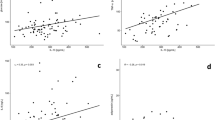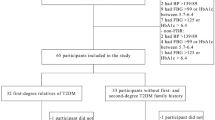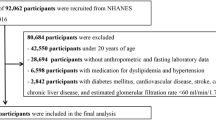Abstract
Background
The resistin/uric index has been considered a prognostic factor for identifying young people with obesity. Obesity and Metabolic Syndrome (MS) are an important health problem in females.
Aims
The objective of this work was to evaluate the relationship of resistin/acid uric index with Metabolic Syndrome on Caucasian females with obesity.
Methods
We conducted a cross sectional study in 571 females with obesity. Measurements of anthropometric parameters, blood pressure, fasting blood glucose, insulin concentration, insulin resistance (HOMA-IR), lipid profile, C reactive protein, uric acid, resistin and prevalence of Metabolic Syndrome were determined. The resistin/uric acid index was calculated.
Results
In total, 249 subjects had MS (43.6%). We detected higher levels in the following parameters (Delta; p values); waist circumference (3.1 ± 0.5 cm; p = 0.04), systolic blood pressure (5.3 ± 3.6 mmHg; p = 0.01), diastolic blood pressure (2.3 ± 0.4 mmHg; p = 0.02), glucose levels (7.5 ± 0.9 mg/dL; p = 0.01), insulin levels (2.5 ± 0.3 UI/L; p = 0.02), HOMA-IR (0.7 ± 0.2 units; p = 0.03), uric acid levels (0.9 ± 0.2 mg/dl; p = 0.01), resistin levels (4.1 ± 0.4 ng/dl; p = 0.01) and resistin/uric acid index (0.61 ± 0.01 mg/dl; p = 0.02) in subjects of the high resistin/uric acid index group than low index group. Logistic regression analysis reported a high percentage of hyperglycemia (OR = 1.77, 95% CI = 1.10–2.92; p = 0.02), hypertension (OR = 1.91, 95% CI = 1.36–3.01; p = 0.01), central obesity (OR = 1.48, 95% CI = 1.15–1.84; p = 0.03) and metabolic syndrome percentage (OR = 1.71, 95% CI = 1.22–2.69; p = 0.02) in high resistin/uric acid index group.
Conclusions
Resistin/uric acid index is related with Metabolic syndrome (MS) risk and criteria of it in a population of Caucasian females with obesity and this index is a correlated with glucose levels, insulin levels and insulin resistance (HOMA-IR).
This is a preview of subscription content, access via your institution
Access options
Subscribe to this journal
Receive 12 print issues and online access
$259.00 per year
only $21.58 per issue
Buy this article
- Purchase on Springer Link
- Instant access to full article PDF
Prices may be subject to local taxes which are calculated during checkout
Similar content being viewed by others
Data availability
All data generated or analyzed during this study are included in this article. Further enquiries can be directed to the corresponding author.
References
Finucane MM, Stevens GA, Cowan MJ, Danaei G, Lin JK, Paciorek CJ, et al. National, regional, and global trends in body-mass index since 1980: systematic analysis of health examination surveys and epidemiological studies with 960 country-years and 9.1 million participants. Lancet. 2011;377:557–67.
Gutiérrez-Fisac JL, Guallar-Castillón P, León-Muñoz LM, Graciani A, Banegas JR, Rodríguez-Artalejo F. Prevalence of general and abdominal obesity in the adult population of Spain, 2008–2010: the ENRICA study. Obes Rev. 2012;13:388–92.
Samuel VT, Shulman GI. Mechanisms for insulin resistance: common threads and missing links. Cell. 2012;148:852–71.
Pagano C, Marin O, Calcagno A, Schiappelli P, Pilon C, Milan G, et al. Increased serum resistin in adults with Prader Willi syndrome is related to obesity and not to insulin resistance. J Clin Endocrinol Metab. 2005;90:4335–40.
Burnett MS, Devaney JM, Adenika RJ, Lindsay R, Howard BV. Cross-sectional associations of resistin, coronary heart disease and insulin resistance. J Clin Endocr Metab. 2006;91:64–68.
Zou CC, Liang L, Hong F, Fu JF, Zhao ZY. Serum adiponectin, resistin levels and non alcoholic fatty liver disease in obese children. Endocrine J. 2005;52:519–24.
Steppan CM, Wang J, Whiteman EL, Birnbaum MJ, Lazar MA. Activation of SOCS-3 by resistin. Mol Cell Biol. 2005;25:1569–75.
Hsia SH, Chou IJ, Kuo CF, See LC, Huang JL, Yu KH, et al. Survival impact of serum uric acid levels in children and adolescents. Rheumatol Int. 2013;33:2797–802.
Safiri S, Qorbani M, Heshmat R, Tajbakhsh R, Eslami Shahr Babaki A, Djalalinia S, et al. Association of serum uric acid with cardiometabolic risk factors and metabolic syndrome in Iranian Adolescents: the CASPIAN-III Study. Iran J Kidney Dis. 2016;10:126–34.
Sautin YY, Nakagawa T, Zharikov S, Johnson RJ. Adverse effects of the classic antioxidant uric acid in adipocytes: NADPH oxidase-mediated oxidative/nitrosative stress. Am J Physiol Cell Physiol. 2007;293:584–96.
Johnson RJ, Lanaspa MA, Gaucher EA. Uric acid: a danger signal from the RNA world that may have a role in the epidemic of obesity, metabolic syndrome, and cardiorenal disease: evolutionary considerations. Semin Nephrol. 2011;31:394–9.
Expert panel on detection, evaluation and treatment of high blood cholesterol in adults (Adult Treatment Panel III). Executive summary of the Third Report of the National Cholesterol Education Program (NCEP). JAMA. 2001;285:2486–97.
de Luis DA, Izaola O, Primo D, Aller R. Relation of a variant in adiponectin gene (rs266729) with metabolic syndrome and diabetes mellitus type 2 in adult obese subjects. Eur Rev Med Pharmacol Sci. 2020;24:10646–52.
Sayeed G, Varghese SS. Association between periodontitis and metabolic syndrome in females: a systematic review and meta-analysis. J Int Soc Prev Community Dent. 2021;11:609–25.
Zurita-Cruz J, Villasis-Keever M, Manuel-Apolinar L, Damasio-Santana L, Wakida-Kusunoki GH, Padilla-Rojas M, et al. Resistin/uric acid index as a prognostic factor in adolescents with obesity after lifestyle intervention. J Pediatr. 2020;219:38–42.
Lukaski H, Johson PE. Assessment of fat-free mass using bioelectrical impedance measurements of the human body. Am J Clin Nutr. 1985;41:810–7.
Friedewald WT, Levy RJ, Fredrickson DS. Estimation of the concentration of low-density lipoprotein cholesterol in plasma without use of the preparative ultracentrifuge. Clin Chem. 1972;18:499–502.
Mathews DR, Hosker JP, Rudenski AS, Naylor BA, Treacher DF. Homeostasis model assessment: insulin resistance and beta cell function from fasting plasma glucose and insulin concentrations in man. Diabetologia. 1985;28:412–4.
Lehrke M, Reilly MP, Millington SC, Iqbal N, Rader DJ, Lazar MA. An inflammatory cascade leading to hyperresistinemia in humans. PLoS Med. 2004;1:e45.
Aquilante CL, Kosmiski LA, Knutsen SD, Zineh I. Relationship between plasma resistin concentrations, inflammatory chemokines, and components of the metabolic syndrome in adults. Metabolism. 2008;57:494–501.
Kim KH, Zhao L, Moon Y, Kang C, Sul HS. Dominant inhibitory adipocytespecific secretory factor (ADSF)/resistin enhances adipogenesis and improves insulin sensitivity. Proc Natl Acad Sci USA. 2004;101:6780–5.
Gupta V, Singh A, Gupta V, Kumar S, Srivastava N, Jafar T, et al. Association of circulating resistin with metabolic risk factors in Indian females having metabolic syndrome. Toxicol Int. 2011;18:168.
Bednarska-Makaruk M, Graban A, Wiśniewska A, Łojkowska W, Bochyńska A, Gugała-Iwaniuk M, et al. Association of adiponectin, leptin and resistin with inflammatory markers and obesity in dementia. Biogerontology. 2017;18:561–80.
Thomopoulos C, Daskalaki M, Papazachou O, Rodolakis N, Bratsas A, Papadopoulos D, et al. Association of resistin and adiponectin with different clinical blood pressure phenotypes. J Hum Hyperten. 2011;25:38.
Teng X, Li D, Champion HC, Johns RA. FIZZ1/RELMa, a novel hypoxia-induced mitogenic factor in lung with vasoconstrictive and angiogenic properties. Circul Res. 2003;92:1065–7.
Calabro P, Samudio I, Willerson JT, Yeh ET. Resistin promotes smooth muscle cell proliferation through activation of extracellular signal– regulated kinase 1/2 and phosphatidylinositol 3-kinase pathways. Circulation. 2004;110:3335–40.
Singh AK, Tiwari S, Gupta A, Shukla KK, Chhabra KG, Pandey A, et al. Association of resistin with insulin resistance and factors of metabolic syndrome in north Indians. Indian J Clin Biochem. 2015;30:255–62.
de Luis D, Sagrado MG, Conde R, Aller R, Izaola O, Primo D. Lack of association of serum resistin levels with metabolic syndrome criteria in obese female patients. Clin Biochem. 2011;44:1280–3.
Nakanishi N, Suzuki K, Kawashimo H, Nakamura K, Tatara K. Serum uric acid: correlation with biological, clinical and behavioral factors in Japanese men. J Epidemiol. 1999;9:99–106.
Russo C, Olivieri O, Girelli D, Guarini P, Corrocher R. Relationships between serum uric acid and lipids in healthy subjects. Prev Med. 1996;25:611–616.
Ramsay LE. Hyperuricaemia in hypertension: role of alcohol. BrMed J. 1979;1:653–4.
Alper AB Jr., Chen W, Yau L, Srinivasan SR, Berenson GS, Hamm LL. Childhood uric acid predicts adult blood pressure: The Bogalusa Heart Study. Hypertension. 2005;45:34–38.
Krishnan E, Pandya BJ, Chung L, Hariri A, Dabbous O. Hyperuricemia in young adults and risk of insulin resistance, prediabetes, and diabetes: A 15-year follow-up study. Am J Epidemiol. 2012;176:108–116.
Johnson RJ, Lanaspa MA, Gaucher EA. Uric acid: a danger signal from the RNA world that may have a role in the epidemic of obesity, metabolic syndrome, and cardiorenal disease: evolutionary considerations. Elsevier: Seminars Nephrol. 2011;16:234–54.
Matsuura F, Yamashita S, Nakamura T, Nishida M, Nozaki S, Funahashi T, et al. Effect of visceral fat accumulation on uric acid metabolism in male obese subjects: Visceral fat obesity is linked more closely to overproduction of uric acid than subcutaneous fat obesity. Metabolism. 1998;47:929–33.
Goli P, Riahi R, Daniali SS, Pourmirzaei M, Kelishadi R. Association of serum uric acid concentration with components of pediatric metabolic syndrome: A systematic review and meta-analysis. J Res Med Sci. 2020;13:25–43.
Kuwabara M, Borghi C, Cicero AFG, Hisatome I, Niwa K, Ohno M, et al. Elevated serum uric acid increases risks for developing high LDL cholesterol and hypertriglyceridemia: a five-year cohort study in Japan. Int J Cardiol. 2018;261:183–8.
Choi HK, Ford ES. Prevalence of the metabolic syndrome in individuals with hyperuricemia. Am J Med. 2007;120:442–447.
Bulum T, Tomić M, Vučković-Rebrina S, Roso V, Vučić Lovrenčić M, Duvnjak L. Preserved C-peptide secretion in patients with type 1 diabetes and incipient chronic complications is associated with lower serum resistin and higher uric acid levels. J Diabetes Metab Disord. 2020;19:1185–9.
de Luis D, Aller R, Izaola O, Primo D. Role of the rs10401670 variant in the resistin gene on the metabolic response after weight loss secondary to a high-fat hypocaloric diet with a Mediterranean pattern. J Hum Nutr Diet. 2022;35:722–30. Aug
de Luis DA, Izaola O, Primo D, Aller R. Effect of the rs1862513 variant of resistin gene on insulin resistance and resistin levels after two hypocaloric diets with different fat distribution in subjects with obesity. Eur Rev Med Pharmacol Sci. 2018;22:3865–72.
Author information
Authors and Affiliations
Contributions
DdeL designed the study an wrote the article. OI, realized nutritional evaluation. DP and DdeL realized biochemical evaluation.
Corresponding author
Ethics declarations
Competing interests
The authors declare no competing interests.
Ethics statement
This study protocol was reviewed and approved by [HCVUA Commitee], approval number [No 6/2018] Written Informed consent was obtained from all individual participants included in the study.
Consent to participate statement
Signed informed consent was otained in all participants. This research comply with the guidelines for human studies in accordance with the World Medical Association Declaration of Helsinki.
Additional information
Publisher’s note Springer Nature remains neutral with regard to jurisdictional claims in published maps and institutional affiliations.
Rights and permissions
Springer Nature or its licensor (e.g. a society or other partner) holds exclusive rights to this article under a publishing agreement with the author(s) or other rightsholder(s); author self-archiving of the accepted manuscript version of this article is solely governed by the terms of such publishing agreement and applicable law.
About this article
Cite this article
Primo, D., Izaola, O. & de Luis, D. Resistin/uric acid index as a marker of metabolic syndrome in females with obesity. Int J Obes 47, 393–398 (2023). https://doi.org/10.1038/s41366-023-01287-4
Received:
Revised:
Accepted:
Published:
Issue Date:
DOI: https://doi.org/10.1038/s41366-023-01287-4



